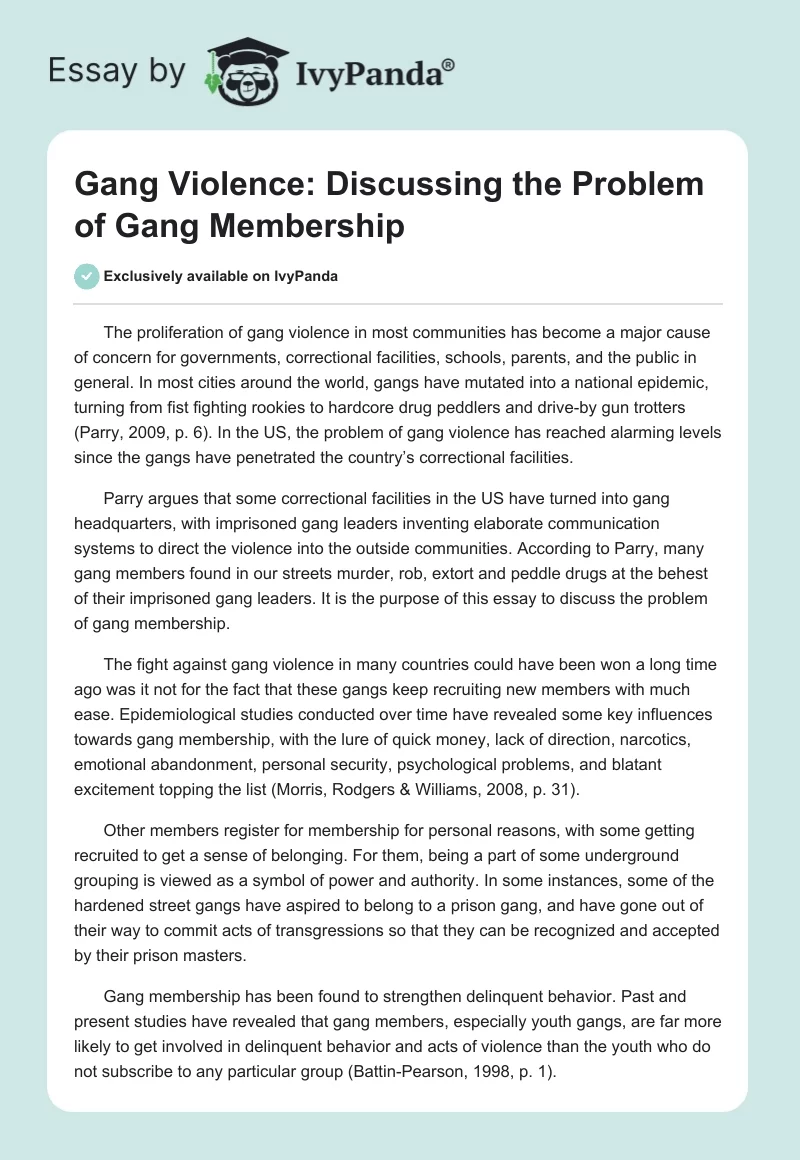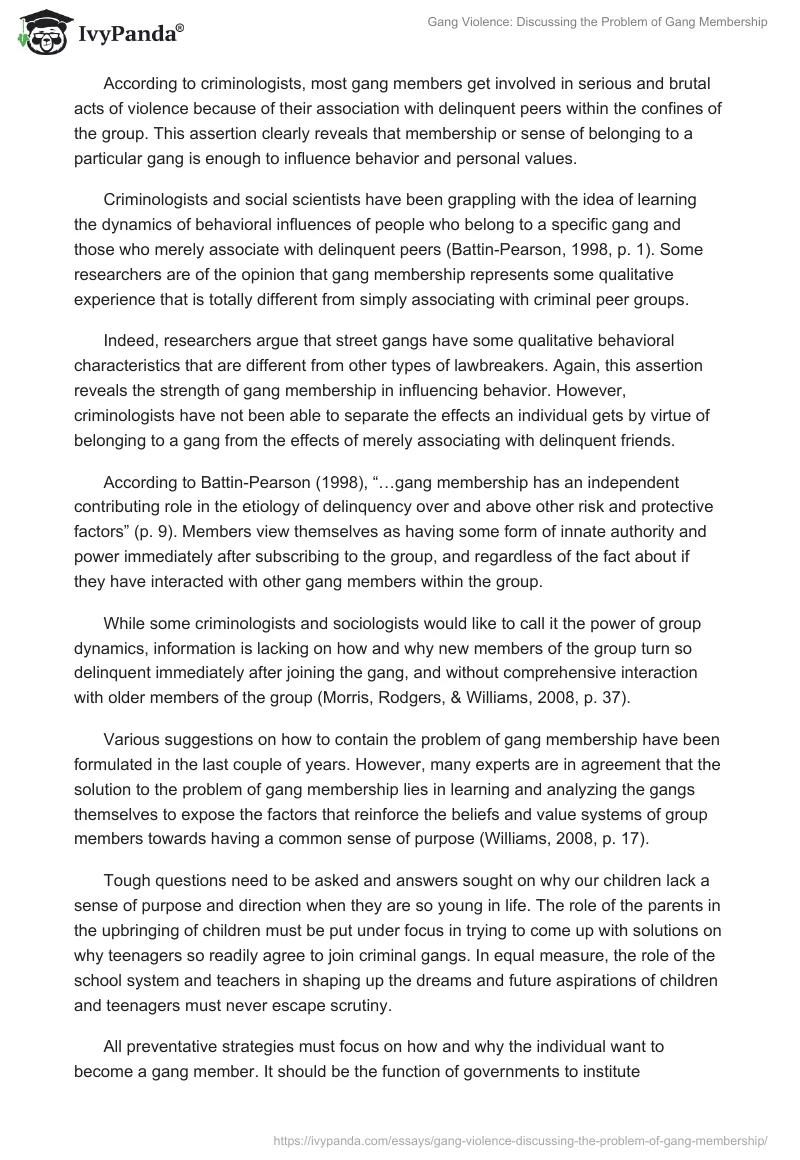The proliferation of gang violence in most communities has become a major cause of concern for governments, correctional facilities, schools, parents, and the public in general. In most cities around the world, gangs have mutated into a national epidemic, turning from fist fighting rookies to hardcore drug peddlers and drive-by gun trotters (Parry, 2009, p. 6). In the US, the problem of gang violence has reached alarming levels since the gangs have penetrated the country’s correctional facilities.
Parry argues that some correctional facilities in the US have turned into gang headquarters, with imprisoned gang leaders inventing elaborate communication systems to direct the violence into the outside communities. According to Parry, many gang members found in our streets murder, rob, extort and peddle drugs at the behest of their imprisoned gang leaders. It is the purpose of this essay to discuss the problem of gang membership.
The fight against gang violence in many countries could have been won a long time ago was it not for the fact that these gangs keep recruiting new members with much ease. Epidemiological studies conducted over time have revealed some key influences towards gang membership, with the lure of quick money, lack of direction, narcotics, emotional abandonment, personal security, psychological problems, and blatant excitement topping the list (Morris, Rodgers & Williams, 2008, p. 31).
Other members register for membership for personal reasons, with some getting recruited to get a sense of belonging. For them, being a part of some underground grouping is viewed as a symbol of power and authority. In some instances, some of the hardened street gangs have aspired to belong to a prison gang, and have gone out of their way to commit acts of transgressions so that they can be recognized and accepted by their prison masters.
Gang membership has been found to strengthen delinquent behavior. Past and present studies have revealed that gang members, especially youth gangs, are far more likely to get involved in delinquent behavior and acts of violence than the youth who do not subscribe to any particular group (Battin-Pearson, 1998, p. 1).
According to criminologists, most gang members get involved in serious and brutal acts of violence because of their association with delinquent peers within the confines of the group. This assertion clearly reveals that membership or sense of belonging to a particular gang is enough to influence behavior and personal values.
Criminologists and social scientists have been grappling with the idea of learning the dynamics of behavioral influences of people who belong to a specific gang and those who merely associate with delinquent peers (Battin-Pearson, 1998, p. 1). Some researchers are of the opinion that gang membership represents some qualitative experience that is totally different from simply associating with criminal peer groups.
Indeed, researchers argue that street gangs have some qualitative behavioral characteristics that are different from other types of lawbreakers. Again, this assertion reveals the strength of gang membership in influencing behavior. However, criminologists have not been able to separate the effects an individual gets by virtue of belonging to a gang from the effects of merely associating with delinquent friends.
According to Battin-Pearson (1998), “…gang membership has an independent contributing role in the etiology of delinquency over and above other risk and protective factors” (p. 9). Members view themselves as having some form of innate authority and power immediately after subscribing to the group, and regardless of the fact about if they have interacted with other gang members within the group.
While some criminologists and sociologists would like to call it the power of group dynamics, information is lacking on how and why new members of the group turn so delinquent immediately after joining the gang, and without comprehensive interaction with older members of the group (Morris, Rodgers, & Williams, 2008, p. 37).
Various suggestions on how to contain the problem of gang membership have been formulated in the last couple of years. However, many experts are in agreement that the solution to the problem of gang membership lies in learning and analyzing the gangs themselves to expose the factors that reinforce the beliefs and value systems of group members towards having a common sense of purpose (Williams, 2008, p. 17).
Tough questions need to be asked and answers sought on why our children lack a sense of purpose and direction when they are so young in life. The role of the parents in the upbringing of children must be put under focus in trying to come up with solutions on why teenagers so readily agree to join criminal gangs. In equal measure, the role of the school system and teachers in shaping up the dreams and future aspirations of children and teenagers must never escape scrutiny.
All preventative strategies must focus on how and why the individual want to become a gang member. It should be the function of governments to institute consultative meetings with professionals to offer guidance on how to look for the first symptoms of gang membership (Decker & Weerman, 2005, p. 265). Such training should be aimed at professionals such as community and social workers, psychologists, youth workers, pastoral care agents, medical practitioners and the youth.
Some of the high-risk factors towards gang membership that must be highlighted in these consultative meetings include emotional challenges, physical violence and aggression, antisocial behavior, alcohol and drug abuse, and terminal exclusion from learning facilities. If the symptoms are found on individuals, it should be the function of the professionals to counsel the aggrieved using approaches that will enable them to rediscover their potential and purpose in life.
Experts are in agreement that there is no easy way to curtail individuals from joining gangs because the underlying influences that lead to the trend are multifaceted. Police crackdowns are good, but they only temporarily curtail gang activity in a particular area. As such, it is imperative for governments and other interested stakeholders to directly deal with the individual and the pull-and-push factors of gang life.
Various factors such as poverty, peer pressure, boredom and despair are known to make individuals gravitate towards joining the youth and street gangs (Decker & Weerman, 2005, p. 263). Using a holistic individual approach described above, all stakeholders concerned must try to solve this problems from the individual point of view. In essence, the concerned individual must be given something to live for other than be left at the whims of cruel gangs.
All in all, it is clear that gang membership is on the rise in the U.S. According to the National Gang Threat Assessment (NGTA), there are in excess of 21, 500 gangs in the country alone, with a membership of at least 731,000 gang members (Grabianowski, 2009, para 1).
This is an enormous problem if the figures are anything to go by. Stakeholders must act with speed to prevent any more people from joining. Any corrective measure should target the culprits and the underlying issues that make them desire to join street gangs, known to be violent in nature.
Reference List
Battin-Pearson , S.R., Thornberry, T.P., Hawkins, J.D., & Krohn, MD. (1998). Gang Membership, delinquent peers, and delinquent behavior. Web.
Decker, S.C., & Weerman, F.M. (2005). European street gangs and troublesome youth groups. Oxford: Rowman Altamira Press.
Grabianowski, E. (2009). How street gangs work. Web.
Morris, D.J., Rodgers, T., & Williams, T. (2008). War of the bloods in my veins: A street Soldier’s march toward redemption, 1st Ed. Web.
Parry, B. Corrections must lead the fight against youth gangs. Corrections Today, Vol. 71, Issue 1, p. 6.
Williams, S.T. Gangs and violence. Damamli Publishing Company. Web.


